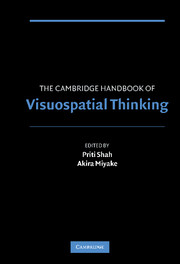Book contents
- The Cambridge Handbook of Visuospatial Thinking
- The Cambridge Handbook of Visuospatial Thinking
- Copyright page
- Contents
- List of Contributors
- Preface
- Acknowledgments
- 1 Functional Significance of Visuospatial Representations
- 2 Visuospatial Images
- 3 Disorders of Visuospatial WorkingMemory
- 4 Individual Differences in Spatial Abilities
- 5 Sex Differencesin Visuospatial Abilities
- 6 Development of Spatial Competence
- 7 Navigation
- 8 Mapping the Understanding of Understanding Maps
- 9 Spatial Situation Models
- 10 Design Applications of Visual Spatial Thinking
- 11 The Comprehension of Quantitative Information in Graphical Displays
- 12 Multimedia Learning: GuidingVisuospatial Thinking with Instructional Animation
- Author Index
- Subject Index
9 - Spatial Situation Models
Published online by Cambridge University Press: 05 June 2012
- The Cambridge Handbook of Visuospatial Thinking
- The Cambridge Handbook of Visuospatial Thinking
- Copyright page
- Contents
- List of Contributors
- Preface
- Acknowledgments
- 1 Functional Significance of Visuospatial Representations
- 2 Visuospatial Images
- 3 Disorders of Visuospatial WorkingMemory
- 4 Individual Differences in Spatial Abilities
- 5 Sex Differencesin Visuospatial Abilities
- 6 Development of Spatial Competence
- 7 Navigation
- 8 Mapping the Understanding of Understanding Maps
- 9 Spatial Situation Models
- 10 Design Applications of Visual Spatial Thinking
- 11 The Comprehension of Quantitative Information in Graphical Displays
- 12 Multimedia Learning: GuidingVisuospatial Thinking with Instructional Animation
- Author Index
- Subject Index
Summary
In this chapter, I review empirical and theoretical work on spatial situation models created from texts. Deep comprehension of a text involves the construction of a model representing the situation described in the text. One particular type of information represented in this situation model is spatial information, therefore the term spatial situation model. The empirical evidence reviewed in this chapter is organized around three research questions: First, do readers create spatial situation models during reading? I review a large body of evidence suggesting that they do. Second, what is the nature of spatial situation models? To answer this question, I describe empirical studies that explored the role of spatial information, the metrics and neuropsychological correlates of spatial situation models, individual differences in constructing these models, and models created from instructional texts. In addition, theoretical views of spatial situation models are reviewed. Third, what are the limitations of spatial situation models? In answering this question, I review a number of studies that challenge the assumption that spatial information is an important dimension of situation models. Finally, I discuss the possible future of multidimensional situation models and spatial situation models.
Keywords
Information
- Type
- Chapter
- Information
- The Cambridge Handbook of Visuospatial Thinking , pp. 334 - 382Publisher: Cambridge University PressPrint publication year: 2005
Accessibility standard: Unknown
Why this information is here
This section outlines the accessibility features of this content - including support for screen readers, full keyboard navigation and high-contrast display options. This may not be relevant for you.Accessibility Information
- 11
- Cited by
